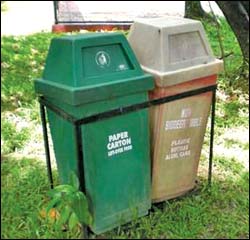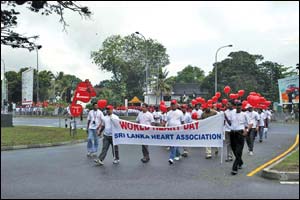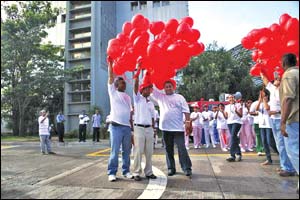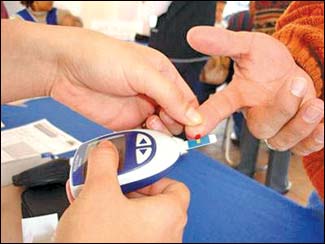|
HEALTH WATCH
Garbaging your health!
Nadira Gunatilleke
Health Minister Maithripala Sirisena revealed a very important piece
of information during a recent ceremony and he repeatedly mentioned the
same fact several times during various ceremonies held last week. But it
seems the fact did not receive adequate publicity through the media.

Minister Sirisena said that during past three months no rabies deaths
were reported from the country as a result of destroying garbage under
the National Dengue Control Program implemented countrywide.
This should be a `breaking news’ for Sri Lankans. Rabies is not the
only disease promoted through garbage. There are many other diseases.
There is no need to say that it is garbage which cause the majority of
health problems in Sri Lanka. But this bitter truth had been ignored by
the relevant authorities and the public during the past until garbage
mountains were removed under the National Dengue Control Program
implemented by the Presidential Task Force with the assistance of armed
forces.
Now Minister Sirisena is planning to have a sustainable national
program covering the whole country to dispose garbage properly as one of
the key steps to establish a healthy nation. It will be done in
coordination with relevant ministries. But no program will bring
successful results without the active participation of the public.
Active participation of the public comes through having the right
attitude.
What is the present attitude of the public on garbage and garbage
disposal? It is clearly visible all over the country.
Here is the current attitude of the public on garbage and garbage
disposal. It is the sole responsibility of the state to collect garbage
and dispose properly. The public have nothing to do with it. The public
can collect the garbage as they wish and dispose garbage as they wish no
matter how where and when!
|

The practice of throwing garbage by the roadside... |
Garbage mountains can be ignored and there is no impact of them on
human life. Sri Lanka has some of the highest health indicators and one
of the highest literacy rates in the world. But this is the attitude of
the Sri Lankan public on garbage disposal. Foreigners who visit Sri
Lanka may be wondering whether Sri Lankan have healthy noses!
The Sri Lankan public is dangerously ignorant about the connection
exist between garbage and health. For example they did not see the
direct connection between the garbage and rabies until it was proved by
the National Dengue Control Program. The garbage problem is something
that can be ignored for the Sri Lankan public. The only people who fight
against garbage are the ones who reside next to huge garbage mountains.
The smell, flies, stray dogs are not `issues’ for the majority of the
Sri Lankan public. That is how thousands of unhygienic food outlets
operate countrywide without a good income.
If there is a huge garbage mountain next to your home, What would you
do about that? Usually the residents of the area ignore garbage
mountains or act against garbage dumping once or twice. That ends there.
Most of the times garbage does not come to a place from far away. The
residents of the same area dump garbage. Rarely you can see a Buddha
statue standing tall at a place where a huge garbage mountain located
earlier. This is the only practically successful step that can be taken
by the resident to stop garbage dumping and they do this rarely.
No Sri Lankan is interested in collecting their garbage separately in
order to dispose properly. The accepted method of garbage collecting is
collecting the garbage in separate bags/bins as the stuff that decay and
the stuff that can be recycled or not decaying. But no Sri Lankan home
collect garbage according to this system. What they do is collecting
everything into one sili sili bag and dispose the bag somewhere.
|

No rabies deaths recorded over past three months |
Nowadays some Sri Lankans have developed an extremely negative method
of garbage collecting and disposing. They collect garbage into a bag no
matter how large their home garden is.
Even when they live in a 25 perch land, they collect garbage into a
bag.
|

Genaral ideology: Garbage mountains can be ignored... |
They collect it as a mixture of everything including food waste,
paper waste, glass waste, plastic waste and sometimes iron waste.
They keep their garbage for the maximum time possible.
After that they wait till midnight and throw the garbage bag by the
roadside or anywhere else they can find! There are some people who burn
their garbage including plastic and polythene polluting the air of the
whole area!
This is not so when it comes to countries like Sweden where the
public is very concerned about garbage and garbage disposal.
The public is well disciplined when it comes to disposing garbage.
The country has tough rules and regulations on garbage disposal. No
wonder walking on roads in Sweden make people healthy and selected the
country as one of the best places in the world to live. But it is the
opposite when it comes to Sri Lanka.
There is a very small connection between garbage disposal and the
economic status of the country. What matters is attitude and the tough
law. This is what lacking in Sri Lanka.
Saving lives through awareness
Lanka Hospitals partners Sri Lanka Heart Association
:
For nearly four decades the Sri Lanka Heart Association (SLHA) has
championed the cause of preventing heart related diseases through proper
preventive steps. Each year, a deserving organization is chosen to
partner the SLHA on its annual heart health walk, held on World Heart
Day.
|

The Sri Lanka Heart Association, Lanka Hospital, Cardiologist
and public preparing for the heart walk. |
|

Cardiologist starting the walk from the D S Senanayaka College
junction |
|

Cardiologist consultant, (Dr Santharaj) Cardiologist, (Dr
Gotabhaya Rajasinghe) Lanka Hospitals CEO Lalith Peiris |
This year’s partner, Lanka Hospitals has been a driving force behind
the development of health care standards and practices in many medical
spheres.
The theme for this year’s walk was “Work place wellness – take
responsibility for your own heart”- focusing on easy and effective
preventive steps that, in the long term, will help patients reduce the
risk of heart diseases and ailments to a staggering degree.
The walk was held on September 26 starting at 6.30am at the D.S.
Senanayake College junction at Borella and ended at Lanka Hospitals
where an event was organized to educate the public about heart health.
The event also featured free cardiac checkups and consultations with
some of Sri Lanka’s leading cardiologists.
Speaking on the event Lanka Hospitals CEO Lakith Pieris emphasized
the need for enhancing the awareness of the walk. “Each year an
estimated 33,000 people suffer from heart related ailments that can be
prevented by educating the public on the simplicity of preventive
methods. With the ever increasing pace of life, people often let their
health take second place to work commitments, while simple and easy to
do preventive methods could save lives.
“Through our partnership with the Sri Lanka Heart Association we
hoped to enhance the general public’s awareness on heart diseases and
help to prevent the development of heart diseases and ailments. We are
very thankful to the SLHA for choosing to partner with us this year and
making the event successful with over a 1000 participants”. Having
consistently maintained that the key to good heart health is through
preventive methods and awareness, the SLHA has always been at the
forefront in enhancing the standards of heart health across the island.
“The mortality rate of heart ailments is one of the highest in Sri
Lanka and around the world. The fact remains that once you are diagnosed
with a heart ailment, taking measures to prevent the condition
deteriorating becomes a lifelong challenge. This is why it is so
important to educate the public on the steps that can be taken to
prevent heart ailments from occurring. Through participation at the
walk, we pledge our commitment to reducing the number of deaths related
to heart ailments and pledge our commitment to continuing our campaign
to enhance the standards of heart health in Sri Lanka,” President of
SLHA President Dr. W. S. Shanthiraj said speaking on the importance of
the event.
Diabetes Mellitus:
Complications avoided in early identification
Dr. SHANTHA HETTIARACHCHI
He had been admitted to the accident service of a leading hospital
with multiple injuries. This unexpected journey was due to a road
traffic accident, that he met, while travelling in a motorcycle to his
workplace as a routine in the morning. While receiving proper care at
this moment, he found that he has lived with a very high level of blood
glucose without any clue.
|

Testing for blood glucose |
This middle aged public servant was tested for blood glucose at this
time as he has a family history of diabetes. Then more attention had to
be given for newly found diabetic status than his immediate problem,
resulting from the accident. The gravity of the issue was so high as his
blood glucose level was nearly 400 mg per deciliter, more than tripled
the normal value.
This incident is a good example in highlighting the issue of hidden
diseases in anyone’s life. It is a common finding that the clinical
manifestations of chronic non communicable diseases, such as diabetes,
hypertension, cancers may express in years after the initiation of the
illness. There may be some adaptation of the body even to the high level
of blood glucose to hinder the clinical expression of the disease for
longer period but the risk for every systems, organs and tissues of the
body is continuing from the starting point.
Therefore, screening for these diseases are utmost important in
avoiding many preventable complications, especially if there is a family
history of the relevant disease or an identifiable risk factor, such as
obesity, physical inactivity or psychological stress.
Diabetes mellitus is characterized by high blood glucose level or
hyperglycemia due to a deficiency of a hormone, called insulin or
inability or resistance of the cells to make proper response to this
hormone.

According to statistics from the World Health Organization (WHO),
more than 220 million people are currently living with this disease,
worldwide. Nearly 1.1 million people have died of this chronic ailment
in the year of 2005. It has been revealed that the death toll of the
diabetes may double between the period of 2005 and 2030.
The disease burden is more in our region, as 80 percent of diabetic
deaths are reporting in low and middle income countries. It has been
estimated that 1.5 million people in Sri Lanka are suffering from Type 2
diabetes. The disease prevalence has been marked as 10.3 percent in the
country.
Insulin, secreted from the gland of pancreas, is the key hormone
responsible for the storage and controlled release of the glucose,
absorbed through the gastrointestinal tract. Blood glucose levels are
well maintained and regulated in a person while living with daily
changing of the requirements mainly nutrition and physical activities,
through the actions of this hormone. The liver absorbs glucose and
stores it as glycogen to supply the need of the body tissues in
utilization of glucose whenever necessary.
There are two types of diabetes, called Type 1 or Insulin Dependent
Diabetes Mellitus (IDDM) and Type 2 or Non-Insulin Dependent Diabetes
Mellitus (NIDDM). In Type 1, the body does not produce enough insulin
while in the Type 2 diabetes the body cells do not respond to produced
insulin.
In Type 1, the disease may be inherited and developed at younger age.
The child of IDDM patient has an increased susceptibility to the
disease. There is evidence that autoimmune diseases are also linked with
the causation of Type 1 diabetes in some instances. Autoimmune diseases
may develop when there is a failure to recognize the body’s own tissues
as self, by the immune system and attack on them.
In Type 2, the patients are usually older and often overweight. There
is no evidence of immune involvement in the causation but someone may
have easy access to the disease when there is a family history of Type 2
diabetes. Physical inactivity, unhealthy diet and mental stress are the
major risk factors for the disease similar with other non communicable
diseases.
The clinical manifestations will develop rapidly in Type 1, but
slowly in Type 2 diabetes. Polyuria or frequent urination, nocturia or
necessity to urinate in the night, thirst and weight loss are among the
main complaints of the patients. Sometimes , especially in the Type 2
disease, lack of energy or tiredness, blurred vision or itching in the
genital region due to frequent fungal infection may be the first clue to
the fairly old unknown ownership for this gift.
There is an advantage in detecting normal or diabetic status early,
through the testing of blood glucose. There are two basic tests, namely,
Fasting glucose and Two hour glucose testing in reaching the diagnosis.
 Fasting
glucose test to be done after 8 hours of fasting. It takes as normal, if
the value is less than 110 miligram per deciliter or 6.1 milimole per
liter. If it is more than 126 miligram per deciliter or 7.0 milimole per
liter, diagnosis of diabetes is confirmed. Fasting
glucose test to be done after 8 hours of fasting. It takes as normal, if
the value is less than 110 miligram per deciliter or 6.1 milimole per
liter. If it is more than 126 miligram per deciliter or 7.0 milimole per
liter, diagnosis of diabetes is confirmed.
A Two hour glucose test is to be done after two hours of giving 75mg
of glucose orally. It takes as normal, if the value is less than 140
miligram per deciliter or 7.8 milimole per liter. If it is more than 200
miligram per deciliter or 11.1 milimole per liter, status of diabetes
will be revealed.
Another additional test in diagnosing and monitoring the control of
diabetes is , Glycated haemoglobin test. The value of this test is more
than 6.5 percent in diabetes. This test is important in reviewing the
control of the disease while adhering to drug therapy and lifestyle
changes. Testing must be beneficial at age of 45 years in any adult and
adults who are overweight (Body Mass Index is more than 25 kilograms per
square meter) or having one or more risk factors such as family history
of diabetes, physical inactivity or mental stress at any age. If the
tests are normal, repeat testing should be carried out at three year
intervals.
There is a term, called pre-diabetes, in which the blood glucose
levels are higher than normal but not high enough to diagnose as
diabetes. The 100 to 125 mg per dl or 5.6 to 6.9 mmol per liter fasting
blood glucose level (impaired fasting glucose) or 140 to 200 mg per dl
or 7.8 to 11.1 mmol per liter blood glucose level, two hours after
taking 75mg glucose (impaired glucose tolerance test) is included in
this pre diabetic stage.
As they may end with Type 2 diabetes later, it is suggested to repeat
the testing once a year in these instances instead of once in three
years in a normal person.
A person may end up with complications, when the disease state is not
revealed for a longer period or if it was not controlled properly after
knowing the diagnosis. Skin infections, retinopathy with visual
impairment, polyneuropathy with numbness and tingling sensation,
diseases of the blood vessels and impotence could be considered as the
main complications of the undiagnosed or uncontrolled diabetes.
Therefore, prevention as well as the control of the diabetes are
equally important in ensuring the qualitative life.
Everyone should think about regular exercises or physical activities,
maintenance of healthy body weight, healthy diet, mental relaxation and
proper control and follow up with medication when it is diagnosed in
this context. It should not be forgotten that the basic knowledge and
healthy attitudes will protect the life from many risks. |



